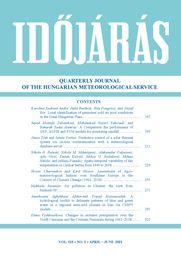IDŐJÁRÁS - angol nyelvű folyóirat
Vol. 125, No. 2 * Pages 167–336 * April - June 2021
 |
|
 letöltés [pdf: 4520 KB]
letöltés [pdf: 4520 KB]
Spatiotemporal variability of air temperatures in Central Serbia from 1949 to 2018
Nikola R. Bačević, Nikola M. Milentijević, Aleksandar Valjarević, Ajša Gicić, Dušan Kićović, Milica G. Radaković, Milena Nikolić, and Milana Pantelić
DOI:10.28974/idojaras.2021.2.4 (pp. 229–253)
Nikola R. Bačević, Nikola M. Milentijević, Aleksandar Valjarević, Ajša Gicić, Dušan Kićović, Milica G. Radaković, Milena Nikolić, and Milana Pantelić
DOI:10.28974/idojaras.2021.2.4 (pp. 229–253)
IDŐJÁRÁS folyóirat

Az IDŐJÁRÁS a HungaroMet Nonprofit Zrt. negyedévenként megjelenő angol nyelvű folyóirata
Megrendelhető a journal.idojaras@met.hu címen.
A szerzőknek szánt útmutató itt olvasható.
Megrendelhető a journal.idojaras@met.hu címen.
A szerzőknek szánt útmutató itt olvasható.









